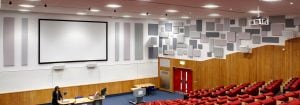Be the first! Get the latest news and updates - Subscribe to our newsletter!
Cost-effective, sustainable, and smart
Educational establishments fulfill a unique role in society; as places of learning, belonging, and community cohesion. From public schools to universities, cost-effective LED lighting can enhance the learning environment, help students feel safe on campus, and strengthen a school's brand and reputation. Philips LED lighting creates inviting outdoor areas and indoor spaces that inspire concentration and focus to support your educational objectives for today, tomorrow, and the future.
Reduce costs
Reduce costs with energy-efficient LED lighting
Adapt light levels and schedules remotely to further reduce energy usage
Schedule maintenance to minimize disruption
Increase safety
Uniform LED lighting minimizes shadows and improves visibility
Adjust light levels to respond to a variety of situations on campus
Remote management enables quick repairs and less downtime
Build brand
Improve quality of life for students, staff, and visitors
Stand out with a well-illuminated campus
Enhance student learning and well-being
Improve sustainability
Support green initiatives with sustainable LED lighting
Reduce energy consumption and carbon footprint
Use light only where and when it is needed
Philips lighting services

Professional Services
Lighting insights and customized design
Are you looking to upgrade your lighting? With your needs and desired outcomes in mind, we’ll assess your existing installation and give you clear insights and advice on how to optimize your lighting plan. This can include everything from a complete redesign to an easy LED retrofit solution.

Lifecycle Services
Extend the life of your lighting installation
Your lighting infrastructure is one of your organization’s most valuable and critically important assets, so you’ll want to protect that investment. With the right maintenance plan and remote assistance, we can help you extend the products’ lifetime and optimize their performance, with fewer interruptions and unexpected costs.

Managed Services
Outcome-based performance for your lighting
For total peace-of-mind, why not completely outsource your lighting infrastructure? Our Managed Services have got you covered – from the initial design and installation to continued hassle-free operation and maintenance. We will even factor in economic sustainability and help you minimize your carbon footprint.
Inspired?
Reach out to your local contact center
for questions and inquiries

